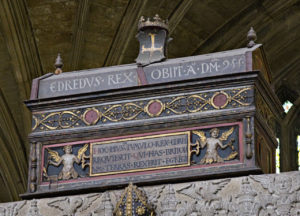
Winchester Cathedral is breathtakingly beautiful and formidable at first sight. Knowing that Canute is said to be buried there, I gazed at the stone foundations of the non-existent Anglo-Saxon Minster with some trepidation. The footprint of the Old Minster butts up against the cathedral, and I wondered what happened to all the bones of saints and kings who resided there before it was demolished in 1093.
Inside, I had to ask three guides before I found one who knew Canute’s name. “Come, I’ll show you” said a nice elderly gentleman, who was surprised we were American. Usually only Danish visitors asked about Canute, he said. I was glad we asked for help; hundreds of people are interred in the cathedral, and he walked us most the way to the back of the building, to the medieval-era chapel whose inside walls only reached three-quarters of the way to the vaulted ceiling.
Our guide pointed to a painted wooden chest sitting on a shelf atop the wall, 15 feet above our heads. “He’s there,” the gentlemen said, then pointed to another chest across the chapel, “and he’s there,” he said, then pointed to a third painted chest, “and he’s probably there.” I just blinked at him, speechless (this rarely happens to me).

It turns out that during the English civil war, Parliamentary forces vandalized Winchester Cathedral and scattered the ashes of our Anglo-Saxon and Norman kings and bishops all over the floor. There were originally eight Mortuary Chests, as they are called, and now only six remain. So the survivors swept up the bones, hopelessly mixed up, and deposited them carefully into the six chests, where Canute keeps company with his wife Emma, son Harthacnut, Bishop Stigand, King Egbert, King Ethelwulf, King William Rufus, and quite a few others going back to the seventh century (even Godwine of Wessex, I trust).
(I keep thinking of someone sweeping up a pile of bones and powder with a broom and a dustpan.) Anyway, it looks like the chests were actually housed in (now empty) cubicles on the other side of the walls, and perhaps the chests were placed high on the shelves for safekeeping? Either way, it was certainly not what I was expecting!
That was many years ago. Since then, a team of archaeologists and anthropologists from the University of Bristol were given permission to actually remove the chests and analyze the bones, using DNA evidence and radiocarbon dating. They have yet to determine the identity of the 23 partial skeletons—if that’s ever going to be possible—but they have concluded that the single female skeleton most likely belonged to Queen Emma, wife of Aethelred the Unready and later Canute the Dane.
robots de piscine says:
I like this very much. “J’aime beaucoup” like we says in French.